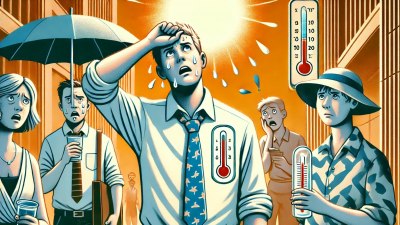Who Decides the Heat Index and Why Does It Always Feel Hotter
Explore the factors influencing the heat index and why it often feels hotter than the actual temperature.

This image was created with the assistance of DALL·E
The heat index, often referred to as the "apparent temperature," is a crucial measure that combines air temperature and relative humidity to determine how hot it feels to the human body. This concept has gained increasing importance, especially as climate change results in more frequent and severe heatwaves.
The National Weather Service (NWS) in the United States is primarily responsible for calculating and disseminating the heat index. The heat index formula was developed by Robert Steadman in 1979. It utilizes a mathematical formula that incorporates both temperature and humidity to assess what the temperature feels like to the average person.
This formula is based on the understanding that our bodies cool off primarily by sweating. When humidity is high, the moisture in the air makes it difficult for sweat to evaporate from our skin, preventing the natural cooling effect. As a result, even when the thermometer reads a particular temperature, high humidity levels can make it feel much hotter.
To better understand why it often feels hotter than what is displayed on thermometers, consider three fundamental aspects: humidity, temperature thresholds, and the human body’s physiology. Humidity plays a significant role in the heat index. When relative humidity rises above 40-50%, the air begins to feel sticky, and our ability to cool down through perspiration diminishes. The NWS categorizes the heat index into zones, ranging from caution to extreme danger, based on the combined figures of heat and humidity.
Understanding the Heat Index
The heat index provides critical information about how dangerous the weather can feel to an individual, particularly during hot summer months. For instance, if the air temperature is a sweltering 90°F but the humidity level is high, the heat index can soar to a dangerous 105°F or higher. This substantial difference between the heat index and the actual temperature is compounded by the activity level of individuals. During vigorous activities, body temperatures rise, leading to an even more significant discrepancy as higher exertion combined with elevated humidity can cause serious heat-related illnesses.
Forecasting the heat index is not just a matter of plugging numbers into an equation; it takes into account various variables, including regional climate patterns, current weather conditions, and geographical influences. Depending on where one is located, the heat index can vary dramatically despite similar temperatures being recorded elsewhere. Regions closer to bodies of water often experience higher humidity, while arid deserts may have high temperatures but considerably lower humidity.
The Health Implications
Many people are unaware of the health risks associated with high heat indices. Understanding these implications is crucial for populations particularly vulnerable to heat-related illnesses, such as the elderly and individuals with pre-existing health conditions. Prolonged exposure to high heat indices can lead to heat exhaustion, heat cramps, and, in severe cases, heat stroke, which can be life-threatening.
Organizations including the Centers for Disease Control and Prevention (CDC) recommend preventive measures to combat extreme heat conditions. Staying hydrated is paramount; underestimating the amount of water required can quickly lead to dehydration. It is recommended to avoid strenuous activities during the hottest parts of the day and find shade or air-conditioned environments whenever possible. Wearing lightweight and loose-fitting clothing can aid both in staying cool and allowing for better sweat evaporation.
Why It Feels Hotter
An often-overlooked reason why we feel hotter than the given temperature is the concept of acclimatization. Acclimatization is the body's ability to adapt to changing temperatures over time. Individuals who are accustomed to higher temperatures may perceive heat differently than those who are not. For example, a person who regularly participates in outdoor activities during the summer may have a higher tolerance to heat compared to someone who spends most of their day in an air-conditioned environment. This factor can also contribute to the perception of increased heat during prolonged hot weather events.
Moreover, different weather conditions fluctuate on a seasonal basis, impacting our heat perceptions. For instance, a late summer heat wave might feel particularly unbearable after a cooler spring, as our bodies have not yet had the time to adjust to the rising temperatures. Psychological factors play a significant role; when people know a heat wave is coming, they may mentally prepare themselves for discomfort, heightening their sensitivity to the heat.
Other Influencing Factors
Besides humidity, other factors affecting how hot it feels include wind speed, clothing, and the environment. Wind can offer a cooling effect; a breeze can help enhance sweat evaporation, making it feel cooler. However, on hot, humid days, the cooling effect of the wind is minimal, and the heat index remains high because of the oppressive environment.
Clothing choices can also exacerbate heat perception. Wearing darker, heavier fabrics can trap heat, leading to a greater sensation of warmth. Lighter, moisture-wicking fabrics can help improve the comfort level by allowing the body to breathe. Environmental factors, like urban heat islands (areas that become significantly warmer than their rural surroundings due to human activities), can amplify perceived temperatures and are a growing concern in many urban areas.
Climate Change and Future Heat Indices
As climate change progresses, it is important to consider how the heat index may also change in the future. With increasing global temperatures and extreme weather events becoming more commonplace, the health risks associated with higher heat indices will likely intensify. Experts predict that heatwaves will not only become more frequent but also more severe, leading to higher heat indices even in regions previously accustomed to milder climates.
Climate adaptation strategies will become essential as a means to cope with the increasing heat. Awareness and proactive measures can help mitigate the health risks associated with extreme temperatures. Schools, workplaces, and local governments can strategize to ensure public safety during crucial periods of heat waves. The collaboration between meteorological organizations, health organizations, and local authorities will be more important than ever to craft effective response systems for managing heat-related health advisories.
Community engagement can also play an important role. Teaching individuals about the heat index, how to recognize symptoms of heat-related illnesses, and preventive strategies to reduce exposure can protect vulnerable populations. By empowering people with knowledge, we can better prepare ourselves and our communities for the changes in the climate that will impact our heat experiences in the years to come.
Conclusion
The heat index serves as a vital metric for understanding not just the temperature in quantitative terms but also in relation to human comfort and health. As we navigate through hotter summers, it’s essential to consider the multiple factors that contribute to our perception of heat: humidity, acclimatization, clothing choices, and the urban environment. With this understanding, we can better prepare ourselves for the challenges that hot weather poses and, ultimately, safeguard our health as we continue to face changing climate conditions.











